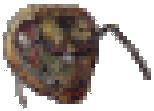 The Evolution of Flight
The Evolution of Flight
Wings
The most accepted theory of the origin of wings suggests that they grew out of a gill-like apparatus
present in the very earliest insects. Some of these gills may have grown over time, after they were
supplanted in the adults by tracheae, to form little flaps. Initially, these proto-wings would have been
useful for little more than jumping, perhaps adding a little to the distance over which an insect could
leap. Gradually these wings would have grown larger, until they could be used for controlled diving,
gliding, and then even flapping flight. The Megasecoptera, a very old order related to the
Odonata, the wing span reached as much as one metre, could flap its wings and even soar (the most
advanced flight mode, practised by the birds and insects with the largest wing spans, involving extended
periods of gliding and requiring great control over the wings and only occasional flapping). Most modern
insects have functional wings as adults, and every order has at least some winged species, so that the
principal criterion for distinguishing insects at all hierarchical levels is the wing morphology.
Compound Eyes
One of the very earliest identifying features of insects is the compound eye, found only among the
insects, the centipedes, the crustaceans, and the horseshoe crabs. The compound eye is composed a large
number (generally a few hundred to thousands) of facets, each of which faces a slightly
different direction than its neighbours. Each facet records a general impression of the colour and
intensity of the light which comes from the direction in which it faces, but does not produce a complete
image. Every facet is bound by is own optic nerve to the insect's brain and contributes one spot of light
to the image, much as the pixels (picture elements) in the monitor in front of you
are doing now or tiles do in a mosaic. The quality of the
picture which an insect sees is determined by the resolution (number of facets) of its eyes, as is the
case with a computer monitor. Shapes are much more clearly defined on a 1024x768-pixel monitor than
are equal size shapes on a 320x240-pixel monitor. Most insects can see fairly well to a few feet, but
not much beyond that. The farther away that an object is, the fewer facets that it covers and the poorer
the resolution of the object. The compound eye system does not require and cannot incorporate a
mechanism for focusing. The clarity or fuzziness of the image is determined by the number of facets, which
is fixed, in the eye and by the insects distance from the object. The sequence of bee head below show, from left to right, the way a human sees a bee's head, the way a bee might see the same head from a short
distance away, and the way a bee might see it from farther away.



There is, however, a great advantage to the compound eye system. Image processing is so much more
efficient than is the case with, for example, a human's eyes, that the compound eye offers a much greater
flicker fusion rate. This means that an insect can assimilate changes in what it's seeing many times more
quickly than we can. A prestidigitator's hand-tricks are transparent to insects, because the hand is
not faster than the compound eye, and a Hollywood movie would look to an insect like a series of
still photographs. The advantage for insects is that compound eyes allow them to fly at high speeds
through dense woods and marshes without hitting anything and to chase other quick-flying insects. They
are also excellent for detecting motion, essentially just recording slight changes in the image over short
intervals. A
side-effect of this, however, is that an insect cannot spot a mate from far away. It detects something
moving, flies over hoping to find a mate, sees when it's close enough that it has found an enemy, and has
to fly as fast as possible away.

 The Evolution of Flight...1, March 1996
The Evolution of Flight...1, March 1996

 The Evolution of Flight
The Evolution of Flight

 The Evolution of Flight...1, March 1996
The Evolution of Flight...1, March 1996